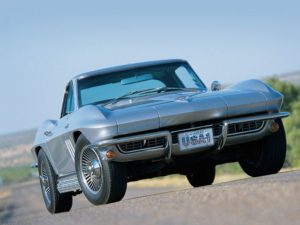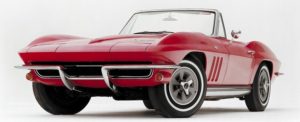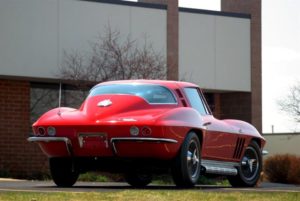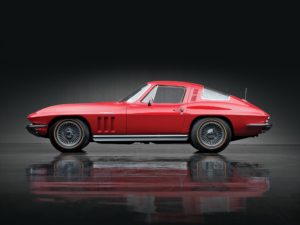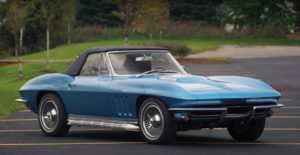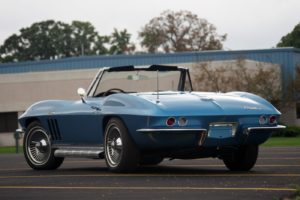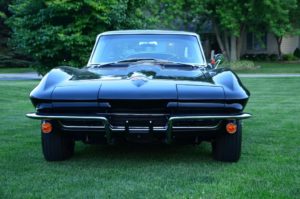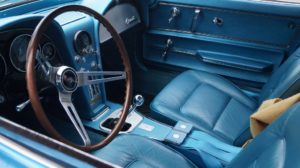As the 1965 model year approached, the design team behind the Chevy Corvette continued to refine the overall design of the C2 Sting Ray, making only minor cosmetic changes in the process. Instead, the focus for the second-generation’s third year centralized on some significant mechanical upgrades that would vastly improve the Corvette’s already impressive handling and drivability.
At the same time, 1965 would also mark the beginning of the end of the second-generation Corvette as Zora Arkus-Duntov and Bill Mitchell each began championing the effort to develop a third-generation Corvette, although each would bring with him a different interpretation of what that next-generation car would be
Pricing: $4321.00 (Coupe), $4106.00 (Convertible)
Engine options: 327ci ohv V8 (fuel injected or carbureted (multiple-horsepower options) 396ci, 425hp ohv V8 engine
Transmission: 3-speed manual (standard), 4-speed manual (optional), 2-speed Powerglide (optional)
Top speed: 152.5
Units produced: 23,564
Available colors: Tuxedo Black, Ermine White, Nassau Blue, Glen Green, Milano Maroon, Silver Pearl, Rally Red, Goldwood Yellow
Highlights of the year:
Bill Mitchell had actually begun laying out the next generation Corvette in late 1964 with the help of Larry Shinoda and General Motor’s design division. The intent from the onset had been to develop a car that could travel the auto-show circuit to serve as a trial balloon for the next-generation Corvette.
Mitchell instructed Shinoda that a suitable preview would have to be ready for the New York International Auto Show before April 1965.
In response to Mitchell’s request, Shinoda’s team of designers developed a full-size mock-up of Mitchell’s next vision for the Chevy Corvette, which they dubbed the “Mako Shark II” (so named because of its long, somewhat flattened front-end, which made the car resemble a shark.)
Whether viewing the mock-up or the actual prototype, there was no question that the car looked fast. An aggressively pointed prow gave way to a domed hood that signified robust power. In both the mockup and the prototype, the bulging wheelhouses at all four corners of the Corvette only enhanced the already aggressive appearance of the car
The most notable change to the outward appearance of the car was the removal of the former scoop indentations, which had carried over in the 1964 model (after the faux hood scoops were removed from the 1963 design.)
A number of noteworthy alterations and additions were made for the 1965 model year – some of which would set a precedence that would carry over to the most current Corvette models being built today. The first of these welcome additions was the introduction of a standard, four-wheel.
The brakes featured a four-piston design with two-piece calipers mated to a newly designed brake rotor which utilized cooling fins. The cooling fins helped to dissipate the massive amount of heat being generated during hard braking.
Suspended between the calipers and rotors was an all-new semi-metallic brake pad. These pads were designed to remain in constant contact with the brake rotors which aided in keeping the braking surfaces on the rotor free from rust and debris (both of which cause pitting and diminish the lifespan of any brake rotor.)
While the drag created by the contact between the pads and rotors was negligible, the benefits of maintaining the rotor condition helped GM to project a life expectancy of 57,000 miles on the front braking system (which, because of the forward weight transfer, supplied most of the braking effort in all-out stops.) Better still, the expected lifespan of the rear brakes was twice that of the front. Pending federal regulations (at/during the development phase of the 1965 Corvette), a dual master cylinder with separate fluid reservoirs for front and rear lines was also introduced. The newly designed master cylinder helped reduce the overall temperature of the brake fluid, which contributed to brake failure in older models.
Another significant improvement and mechanical milestone arrived midway through the 1965 model year. Officially titled the Mark IV, Chevrolet introduced a new, optional, big-block V-8 engine for the first time in a production Corvette.
The Mark IV had actually originated in early 1963 as the “mystery” 427 racing engine that had made its first appearance at the Daytona 500. Despite its official title, the engine was marketed as the Turbo Jet and was made available in three varieties, two 396 cubic inch versions, and a 427 (although a fourth, “heavy-duty” 427 was also created for marine use.)
The engine officially began production in mid-1965.
A number of variants of the Mark IV engine were produced. For its mid-size Chevelle model and all full-size Chevy models, a 325 horsepower and 360 horsepower engine was produced.
The Mark IV engine was an immediate sensation and brought Corvette enthusiasts to their local Chevrolet dealerships in droves. While its introduction late in the model year resulted in limited supply, there was no questioning the long-term potential for an engine that was capable of producing such impressive performance numbers
In all, the 1965 Sting Ray saw a total of 23,564 units sold, making 1965 the most successful sales year for the Corvette yet. Of all the units built, 15,378 were convertibles, accounting for nearly two-thirds of all Corvettes sold in 1965. By comparison, the coupe sold a mere 8,186 units.
Even with the development of a new Corvette underway, the current, second-generation Corvette still had the immediate attention of Chevrolet’s executives.
Given the sales success of the first two model years, there was little doubt by anyone that the 1965 Corvette would be equally successful, or perhaps even surpass previous successes.
Photos of the 1965 Corvette:
Sources:
https://www.corvsport.com/1965-c2-corvette/
https://www.corvsport.com/1965-c2-corvette-image-gallery/
https://jthotshotting.com/immaculately-restored-1965-corvette-stingray/1965-corvette-stingray-interior/
